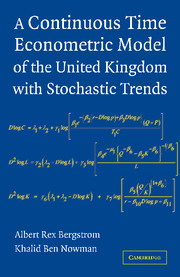Book contents
- Frontmatter
- Contents
- List of Figures and Tables
- Foreword by Peter C. B. Phillips
- Preface
- 1 Introduction to Continuous Time Modelling
- 2 Continuous Time Econometrics with Stochastic Trends
- 3 Model Specification
- 4 Steady State and Stability Analysis
- 5 Empirical Estimation of the Model and Derived Results
- References
- Author Index
- Subject Index
3 - Model Specification
Published online by Cambridge University Press: 03 March 2010
- Frontmatter
- Contents
- List of Figures and Tables
- Foreword by Peter C. B. Phillips
- Preface
- 1 Introduction to Continuous Time Modelling
- 2 Continuous Time Econometrics with Stochastic Trends
- 3 Model Specification
- 4 Steady State and Stability Analysis
- 5 Empirical Estimation of the Model and Derived Results
- References
- Author Index
- Subject Index
Summary
Introduction
In this chapter we discuss the new mixed-order continuous time macroeconometric model of the UK economy with stochastic trends. The model is based on the Bergstrom, Nowman and Wymer [1992] second-order continuous time macroeconometric model. The model is the first continuous time macroeconometric model incorporating stochastic trends, and its development represents a major step forward in general continuous time macroeconometric modelling over the last 30 years. The detailed specification of the structural equations and economic theory of previous continuous time macroeconomic models of various economies of the world is presented, for example, in Bergstrom and Wymer [1976], Knight and Wymer [1978], Bergstrom, Nowman and Wymer [1992], Jonson, Moses and Wymer [1977], Knight and Mathieson [1979], Gandolfo and Padoan, [1982, 1984, 1987a, 1990], Kirkpatrick [1987], Bailey, Hall and Phillips [1987], Donaghy [1993], Sjöö [1993], Nieuwenhuis [1995] and Stavrev [2001], amongst others. In this chapter we provide a rigorous analysis and discussion of each of the macroeconomic structural relationships in the model and a formal derivation of them as the solution of a dynamic optimization problem, which takes account of adjustment costs. We also provide a discussion of the underlying assumptions concerning firm behaviour and market structure.
This chapter is organised as follows. Section 3.2 present the complete set of equations of the model where we shall, also, discuss their general properties. Sections 3.3 and 3.4 present the private consumption and residential fixed capital equations as they have similar specifications.
- Type
- Chapter
- Information
- Publisher: Cambridge University PressPrint publication year: 2007



